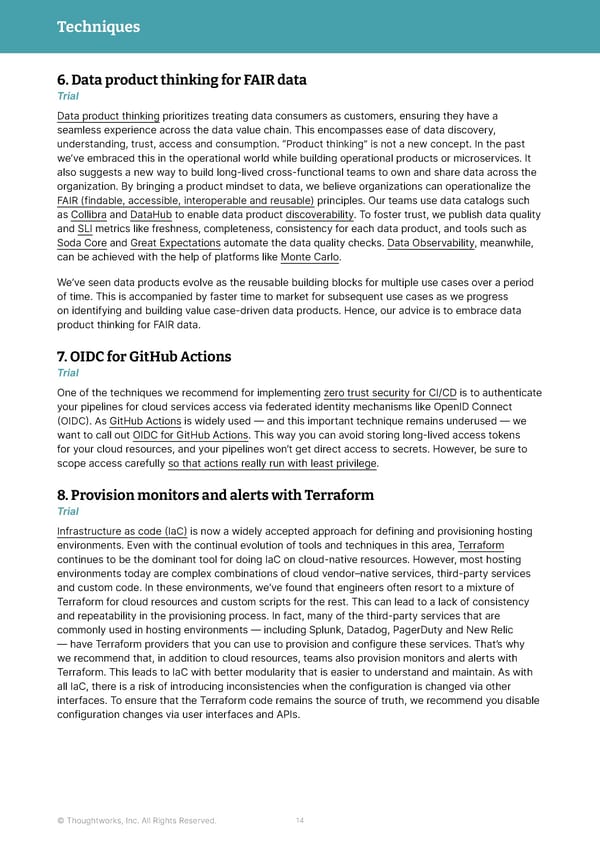Techniques 6. Data product thinking for FAIR data Trial Data product thinking prioritizes treating data consumers as customers, ensuring they have a seamless experience across the data value chain. This encompasses ease of data discovery, understanding, trust, access and consumption. “Product thinking” is not a new concept. In the past we’ve embraced this in the operational world while building operational products or microservices. It also suggests a new way to build long-lived cross-functional teams to own and share data across the organization. By bringing a product mindset to data, we believe organizations can operationalize the FAIR (findable, accessible, interoperable and reusable) principles. Our teams use data catalogs such as Collibra and DataHub to enable data product discoverability. To foster trust, we publish data quality and SLI metrics like freshness, completeness, consistency for each data product, and tools such as Soda Core and Great Expectations automate the data quality checks. Data Observability, meanwhile, can be achieved with the help of platforms like Monte Carlo. We’ve seen data products evolve as the reusable building blocks for multiple use cases over a period of time. This is accompanied by faster time to market for subsequent use cases as we progress on identifying and building value case-driven data products. Hence, our advice is to embrace data product thinking for FAIR data. 7. OIDC for GitHub Actions Trial One of the techniques we recommend for implementing zero trust security for CI/CD is to authenticate your pipelines for cloud services access via federated identity mechanisms like OpenID Connect (OIDC). As GitHub Actions is widely used — and this important technique remains underused — we want to call out OIDC for GitHub Actions. This way you can avoid storing long-lived access tokens for your cloud resources, and your pipelines won’t get direct access to secrets. However, be sure to scope access carefully so that actions really run with least privilege. 8. Provision monitors and alerts with Terraform Trial Infrastructure as code (IaC) is now a widely accepted approach for defining and provisioning hosting environments. Even with the continual evolution of tools and techniques in this area, Terraform continues to be the dominant tool for doing IaC on cloud-native resources. However, most hosting environments today are complex combinations of cloud vendor–native services, third-party services and custom code. In these environments, we’ve found that engineers often resort to a mixture of Terraform for cloud resources and custom scripts for the rest. This can lead to a lack of consistency and repeatability in the provisioning process. In fact, many of the third-party services that are commonly used in hosting environments — including Splunk, Datadog, PagerDuty and New Relic — have Terraform providers that you can use to provision and configure these services. That’s why we recommend that, in addition to cloud resources, teams also provision monitors and alerts with Terraform. This leads to IaC with better modularity that is easier to understand and maintain. As with all IaC, there is a risk of introducing inconsistencies when the configuration is changed via other interfaces. To ensure that the Terraform code remains the source of truth, we recommend you disable configuration changes via user interfaces and APIs. © Thoughtworks, Inc. All Rights Reserved. 14
 Thoughtworks Technology Radar Page 13 Page 15
Thoughtworks Technology Radar Page 13 Page 15